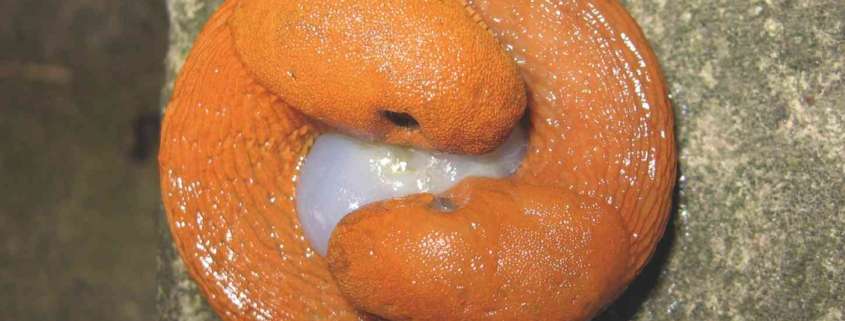FAQ on the Spanish Slug Arion vulgaris
Is the Spanish slug native to Austria?
The origin of the “Spanish” slug is not 100% certain. It is certain that it does not come from Spain, and it has also been disproven that it originally came from Central Europe, as a study from 2014 mistakenly claimed. Therefore, it was not originally native to Austria. It is most likely that it was introduced through vegetable transports from southern France (where it only occurs in a small area due to climatic reasons). Hence, the German name is misleading; sometimes the term “Capuchin slug” is used, but it struggles to replace the widely known term “Spanish slug.”
Does it have predators in our nature?
Unfortunately, almost none, as its extremely sticky slime deters many potential natural enemies. Juveniles are more likely to be eaten, mainly by ground beetles or other predatory slugs like the leopard slug (Limax maximus). Therefore, using slug pellets to control slugs is counterproductive, as it also kills these beneficial slugs. However, if you cut the slugs and leave them, they will be eaten by hedgehogs, ground beetles, leopard slugs, birds (sometimes even chickens), etc.
What does the Spanish slug eat?
It eats almost everything and, unlike most native slug species that prefer wilted plants or dead material, it also massively consumes living plants. Additionally, it feeds on dog feces and dead invertebrates, such as earthworms or dead conspecifics.
Does the Spanish slug compete with native species?
There is direct competition with the native red slug (Arion rufus). Wherever the Spanish slug invades the habitat of the native species, the latter disappears within a few years, and this is also one of the main reasons for the disappearance of this species, which was previously widespread in natural forests. The problem is exacerbated by the similarity between the two species. Distinguishing them based on their external appearance is nearly impossible; only dissection and examination of the sexual organs allow differentiation. For other native slug species, it does not pose a particular threat, as there is usually plenty of food in semi-natural habitats. Habitat changes (forests with conifer trees, pollutant inputs, frequent mowing, and slurry use in meadows) and drought are more significant factors.
However, the Spanish slug also poses a problem for some native, endangered plants. There are now several examples where the massive increase in the Spanish slug in protected areas has severely decimated native, endangered plants. For example, the endemic Bavarian spoonwort (Cochlearia bavarica) and the endangered endemic large-rooted spoonwort (Cochlearia macrorrhiza) at some sites in Lower Austria were unable to reproduce despite optimal habitat management due to slug feeding. Juveniles of the Spanish slug specifically target and completely consume the flowers and seed capsules of these plants.
In summary, does the Spanish slug pose a threat to biodiversity?
Definitely, it has a significant impact on biodiversity. On one hand, as mentioned, it displaces or destroys other species, and on the other hand, it influences human behavior, leading people to combat the unwanted pest. Especially the use of poison (e.g., slug pellets) kills many other animal species, from other slugs to worms to hedgehogs or birds. Additionally, releasing the slugs in other habitats, such as forests or particularly in protected areas, poses a significant threat to biodiversity there. Furthermore, there are numerous reports of hobby gardeners intentionally turning their gardens into gravel deserts because of the slugs, contributing to soil sealing.
What can gardeners do to combat the Spanish slug?
The best approach is to cut the slugs on site and leave them, which strengthens the population of slug predators. For those who find this difficult, the slugs can also be thrown into boiling water or poured over with it, which kills them instantly. Afterward, they can be disposed of in the organic waste bin or compost. It is important to really ONLY target the Spanish slug! In addition to active combat, creating or allowing shelter areas for slug predators in the garden (piles of branches for ground beetles and hedgehogs, mossy meadow areas for the egg-laying of leopard slugs, etc.) can help. A slug fence can often help make certain areas less accessible to slugs. Under no circumstances should slug pellets be used, even if labelled as biological. Every one of these products kills all slugs and not just the Spanish slug. Furthermore, traditional slug pellets also poison hedgehogs, birds, and many other small animals! This is not the case with “biological” products based on iron-III, but as mentioned, these also kill all slugs and some other soil inhabitants.
Is it an option to collect the slugs and release them at stream banks, in forests, etc.?
No! This approach is extremely problematic and also prohibited by nature conservation laws for good reasons. There is a risk of exterminating endangered or threatened native animals, plants, and fungi that are already only found in a few smaller protected areas, and any additional burden or disturbance can be critical. Collecting and relocating the slugs to meadows, forests, and fields has catastrophic consequences, as the animals are spread over natural dispersal barriers (rivers, streams, dry areas, etc.). This can also be seen with the aforementioned spoonworts. Both plant species are mostly found in rather remote moorland areas where the slugs could not easily reach in such numbers on their own.

 A. Mrkvicka
A. Mrkvicka